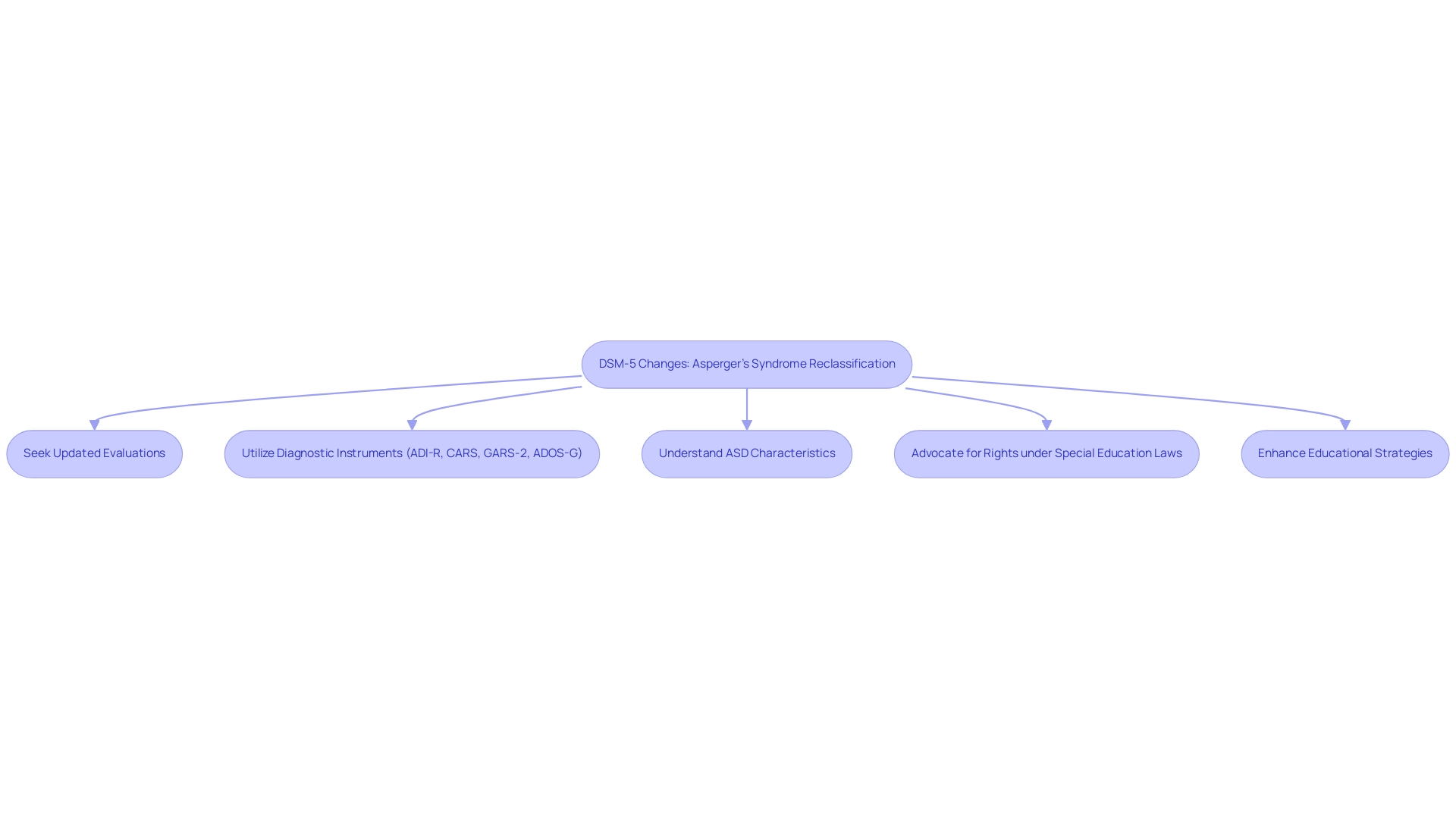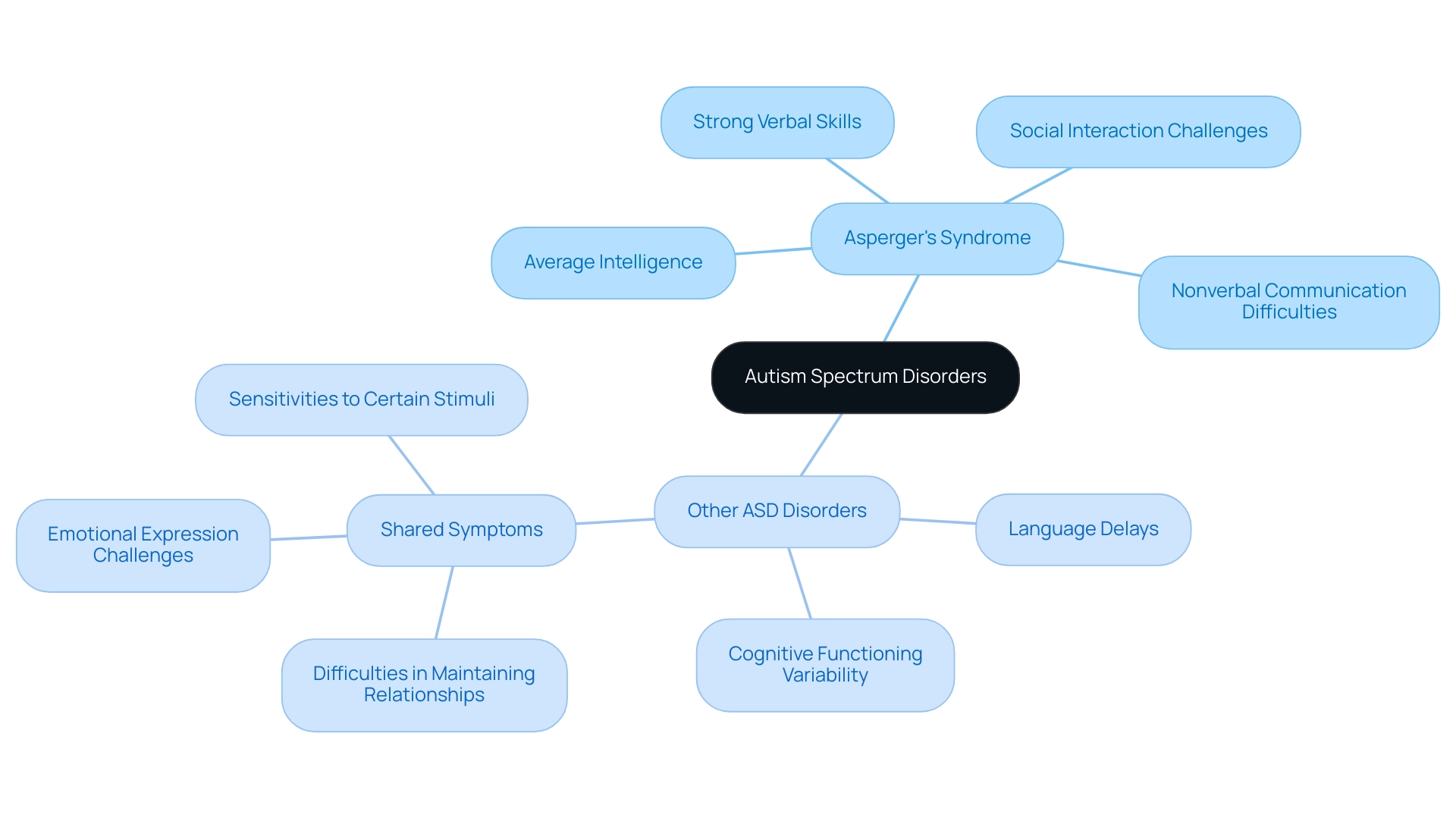Overview
The article focuses on the reclassification of Asperger's syndrome within the Autism Spectrum Disorder (ASD) category in the DSM-5, emphasizing the importance of accurate diagnosis and tailored support for individuals with ASD. This is supported by the article's detailed explanation of the diagnostic criteria, the unique characteristics of Asperger's compared to other forms of ASD, and the implications for parents and educators in advocating for and providing appropriate resources for children on the spectrum.
Introduction
In the evolving landscape of autism diagnosis, the recent changes in the DSM-5 have sparked significant discussions and reflections among parents and educators. The reclassification of Asperger's syndrome under the broader Autism Spectrum Disorder (ASD) umbrella not only reshapes the understanding of autism but also emphasizes the necessity for tailored support and advocacy.
With autism affecting approximately 1 in every 100 children, the importance of accurate diagnosis and appropriate resources cannot be overstated. As families navigate these changes, it becomes essential to grasp the implications for educational strategies and support systems that empower children on the spectrum.
This article delves into the nuances of the DSM-5 updates, the distinct characteristics of Asperger's syndrome, and the vital role of advocacy in fostering an inclusive environment for all children with ASD.
Key Changes in the DSM-5: Understanding Asperger's Syndrome
The reclassification of Asperger's syndrome under the broader category of Autism Spectrum Disorder (ASD) in the Aspergers DSM 5 signifies a pivotal shift in our understanding of this condition. This change acknowledges the diversity of symptoms and abilities individuals may exhibit, reflecting a more nuanced view of the spectrum. As stated by the World Health Organization (WHO), this condition impacts roughly 1 in every 100 youngsters, highlighting the significance of precise diagnosis and customized assistance.
The DSM-5 delineates clear criteria for Aspergers DSM 5, which emphasizes:
- Persistent deficits in social communication and interaction
- Restricted and repetitive patterns of behavior
These refinements aim to enhance diagnostic accuracy, ensuring that children receive the resources necessary for their unique developmental paths. Additionally, symbols such as the butterfly with puzzle-piece wings and the rainbow circle represent the advocacy efforts surrounding developmental disorders, emphasizing community support and awareness.
Notably, statistics indicate that:
- 18.6% of guardians of autistic children meet the criteria for a provisional diagnosis of PTSD, highlighting the emotional toll on families.
- A recent case study titled 'A New Pattern in Racial and Ethnic Differences Emerges in ASD Identification among 8-year-old Children' reveals disparities in ASD identification, which is crucial for understanding the broader context of autism diagnosis.
- Recent news also indicates that caregivers of autistic individuals experience more stress than those with neurotypical individuals, influenced by various factors including individual characteristics and social assistance.
For advocate caregivers and educators, it is crucial to recognize that despite shifts in terminology, the foundational support systems and strategies remain essential for nurturing individuals with ASD. As we navigate these changes, fostering a supportive environment is key to empowering individuals on the spectrum.
Implications of DSM-5 Changes for Parents and Educators
The reclassification of Asperger's syndrome in the Aspergers DSM 5 significantly impacts families and educators alike, emphasizing the crucial role of early and precise diagnosis. With statistics indicating that 95% of individuals in the moderate-to-severe concern range received a diagnosis of Autism Spectrum Disorder (ASD) upon follow-up, it is crucial for guardians to seek updated evaluations for their offspring. Employing diagnostic instruments like the ADI-R, CARS, GARS-2, and ADOS-G can aid in this process, ensuring individuals obtain the customized assistance and accommodations essential for success in educational settings.
Educators must also familiarize themselves with the characteristics of ASD as outlined in the Aspergers DSM 5, as this knowledge equips them to foster inclusive and supportive learning spaces. Moreover, the shift in classification calls on parents to become strong advocates for their offspring by understanding their rights under special education laws. This advocacy is essential in guaranteeing that youth benefit from the necessary services and assistance tailored to their unique needs.
A case study titled 'Change in Symptom Severity by Domain between Time 1 and Time 2' illustrates the impact of early diagnosis, showing that the ASD group demonstrated significant improvements in social communication scores, while highlighting the importance of initial developmental levels in influencing outcomes. Significantly, the reclassification does not diminish the unique experiences of individuals previously diagnosed with Asperger's; instead, it promotes a more comprehensive approach to assistance that acknowledges the variety within the spectrum. As Whitney Guthrie emphasizes, the focus should remain on enhancing educational strategies that support all students on the spectrum, ultimately fostering an environment where every individual can thrive.

Distinguishing Asperger's from Other Autism Spectrum Disorders
Asperger's syndrome, although categorized under the Autism Spectrum Disorder (ASD) umbrella, has unique characteristics that distinguish it from other related disorders. Notably, children with Asperger's often demonstrate average to above-average intelligence, along with strong verbal skills. However, they frequently encounter challenges in social interactions and nonverbal communication, which can hinder their ability to form relationships.
In contrast, other forms of ASD may be characterized by more pronounced language delays and a wider range of cognitive functioning. Recent studies, including a comprehensive analysis involving 24 individuals with Asperger’s and 72 with related conditions, have provided valuable data on shared symptoms such as difficulties in maintaining relationships and emotional expression. According to Alex Klein, PsyD, "Understanding the subtle distinctions between Asperger's syndrome and other autism disorders is crucial for effective intervention."
Additionally, a case study titled 'Gene Co-Expression Network Analysis for Asperger's Syndrome' aimed to explore biological differentiation, following the Asperger's DSM 5's new diagnostic criteria that led to missed diagnoses. Grasping these subtleties is crucial for guardians and educators when developing effective assistance strategies. For example, individuals with Asperger's may thrive in social skills training programs designed to enhance peer interactions, while others may require more focused support in developing communication skills.
Acknowledging these distinctions empowers parents to advocate for tailored educational and therapeutic approaches that recognize and nurture each child’s individual strengths and challenges.

Conclusion
The recent updates to the DSM-5 regarding autism diagnosis represent a significant evolution in understanding and supporting children on the spectrum. By reclassifying Asperger's syndrome under the broader Autism Spectrum Disorder (ASD) category, the DSM-5 highlights the importance of recognizing the diverse abilities and challenges that individuals may face. This change not only enhances diagnostic accuracy but also underscores the critical need for tailored support and resources for families navigating this journey.
For parents and educators, the implications of these changes are profound. It is essential to pursue updated evaluations to ensure that children receive the appropriate educational strategies and accommodations that cater to their unique needs. Empowering parents to advocate for their children’s rights under special education laws is crucial in fostering an inclusive environment where every child can thrive. The commitment to understanding the distinct characteristics of Asperger's syndrome, as well as other forms of ASD, allows for more effective interventions that can significantly improve developmental outcomes.
Ultimately, this shift in classification encourages a holistic approach to supporting individuals on the autism spectrum, emphasizing the shared goal of nurturing each child's potential. By fostering a supportive community and advocating for necessary resources, families and educators can work together to create an environment where all children, regardless of their diagnosis, can flourish. The journey may be complex, but with informed advocacy and a commitment to understanding, brighter futures await children on the spectrum.
Frequently Asked Questions
What is the significance of reclassifying Asperger's syndrome under Autism Spectrum Disorder (ASD) in the DSM-5?
The reclassification acknowledges the diversity of symptoms and abilities individuals may exhibit, reflecting a more nuanced view of the spectrum and enhancing the understanding of the condition.
What are the main criteria for diagnosing Asperger's syndrome according to the DSM-5?
The DSM-5 outlines two main criteria: persistent deficits in social communication and interaction, and restricted and repetitive patterns of behavior.
What is the prevalence of autism, as noted by the World Health Organization (WHO)?
The WHO states that approximately 1 in every 100 youngsters is impacted by autism.
How does the reclassification aim to improve diagnostic accuracy?
The refinements in diagnostic criteria are designed to ensure that children receive the appropriate resources tailored to their unique developmental paths.
What statistics highlight the emotional toll on families of autistic children?
Statistics indicate that 18.6% of guardians of autistic children meet the criteria for a provisional diagnosis of PTSD, underscoring the emotional challenges faced by these families.
What recent findings have emerged regarding racial and ethnic differences in ASD identification?
A case study titled 'A New Pattern in Racial and Ethnic Differences Emerges in ASD Identification among 8-year-old Children' reveals disparities in ASD identification, which is important for understanding the broader context of autism diagnosis.
How does caregiver stress compare between those with autistic individuals and those with neurotypical individuals?
Caregivers of autistic individuals experience more stress than those with neurotypical individuals, influenced by various factors including individual characteristics and social assistance.
What is essential for advocates, caregivers, and educators in light of changes in terminology regarding ASD?
It is crucial to recognize that despite shifts in terminology, the foundational support systems and strategies remain essential for nurturing individuals with ASD, and fostering a supportive environment is key to empowering them.




